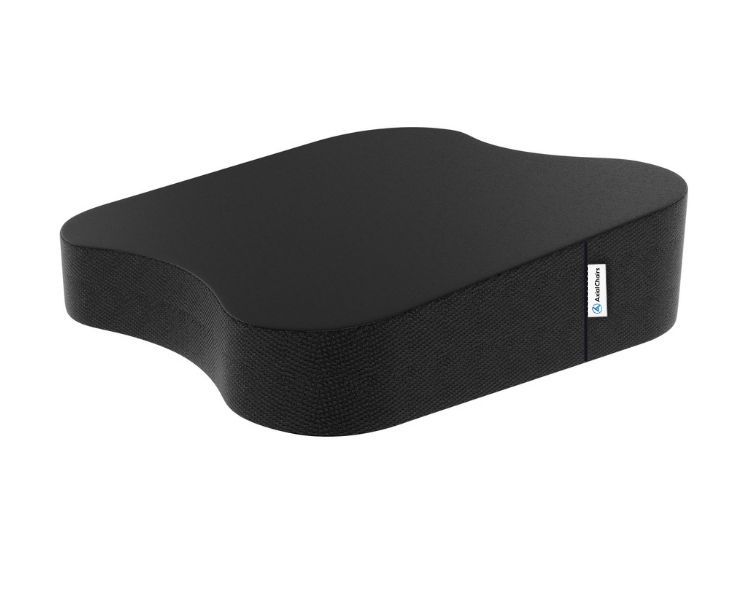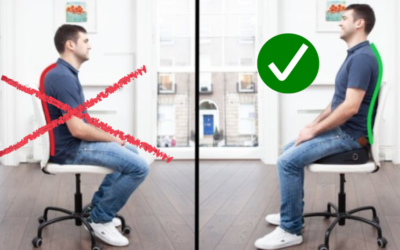If you find yourself sitting for the greater part of the day due to work, driving, or just general lack of movement, chances are that your body has gradually adjusted to become highly efficient at this sedentary activity. Over time, your body optimizes sitting by deactivating specific muscles and over-engaging others. Furthermore, most individuals don’t merely sit but tend to slouch, lean, or adopt different positions to maximize comfort, resulting in numerous issues and imbalances when they’re not seated.
This often leads to the development of a particular posture characterized by a protruding head, a forward-rounded mid-back and shoulders, an overly arched lower back, and a forward-tilted pelvis. Unfortunately, this posture is typically coupled with asymmetries due to varying sitting habits, leading to uneven body tightness and potential discomfort, such as neck, shoulder, and lower back pain. It also complicates certain gym exercises and everyday standing and movement.
However, don’t despair; there are simple methods to rectify this and halt its progression if you sit most of the day. Our understanding from numerous studies shows that these postural patterns formed by sitting are a consequence of certain muscles becoming underactive and weak, and others overactive and shortened, effectively repositioning your body. To reverse this, I’ll guide you through two simple five-minute corrective routines that you can perform virtually anywhere. These routines aim to mobilize these tightened areas, strengthen the weakened ones, and address any asymmetries. The first routine primarily focuses on the upper body, and the second on the lower body, each comprising four exercises. Towards the end, I’ll illustrate how to incorporate these routines into your day.
As a practitioner with over 30 years of practice, and training as an ergonomist and author on sitting, I’m well-equipped to provide valuable insights. My contributions to this field have been well-received, with TV appearances, my Youtube channel, and a successful Kickstarter campaign for my ergonomic seat cushions. If you’re searching for answers, I’m confident that I can offer meaningful guidance.
Get 35% off Orthopedic Seat Cushion Video Guide Video GuideBest Seat Cushion for PostureDoctor's Recommendation
Black Friday Offer!
Product DetailsResearch-based Design
Recommended ForBack Discomfort
3 Lower Body Posture Exercises
Unleashing the power of your hip flexors that have been shackled by prolonged periods of immobility, leading to an anterior pelvic tilt, is our mission today. Let’s start by employing a straightforward kneeling hip flexor stretch. However, don’t be fooled by its simplicity – to make this exercise truly transformative, we need to focus on one detail that often slips under the radar.
Posterior Pelvic Tilt
Our journey begins with a posterior pelvic tilt – achieved by activating your glutes and abs. With your pelvis set in this position, you can then begin to lean forward gently. Savor the intense sensation of your hip flexor stretching on the back leg, keeping it there for about ten deep breaths. Then, invite your other side to join the party.
Extension of Hip Flexors
Next, let’s dig a little deeper, with a stretch that not only amplifies the extension of your hip flexors but also initiates a wider opening of the hips. This works to correct any present asymmetries and paves the way for the forthcoming strengthening exercise. Any couch or elevated platform will serve as your ally. Your front leg, crossed atop the platform, teams up with your extended back leg to bring out the full stretch in your hip flexor. Your hands, secure on your foot and knee, work in harmony with your braced core to bend at your hips, drawing your chest forward. Feel the penetrating stretch on the side of your front hip, modify the angles to suit your needs, and then give your other side the same loving attention.
All Day Comfort & Support
You may find one side stiffer than the other, perhaps a side effect of crossing your legs often when sitting. If so, show this side some extra care. Alternatively, you can opt for a seated stretch, with your foot rested on the opposite knee and your chest leaning forward until the stretch sets in.
Here is my favorite way to create hip flexor extension all day while seated:
I explain the concept of my ergonomic design on a TV show HERE
Building a Cozy (Hip Flexor Extension) Ergonomic Chair: Hints and Proposals
To effectively address your seating preferences, it’s important to pay attention to multiple elements, with chair modification being a significant factor. Various techniques can be employed for this, like adding an ergonomic pad and lumbar backing. These supplementary features can reduce tension on your back and legs, improving comfort and posture during extended periods of sitting. Additionally, ensure your feet are firmly planted on the floor and that there’s adequate clearance between your chair and desk. By observing these suggestions, any conventional firm chair can be transformed into an ergonomic retreat that supports long-lasting health and welfare.
Ergonomic Resting Cushion
A functional ergonomic seat wedge (above) can be applied to position your spine correctly and foster equilibrium. This superior natural latex seating pad aids in reinforcing core muscles while easing pressure in other parts, such as the neck and shoulders. Furthermore, maintaining a straight posture is gentler on your hips and knees, as it utilizes more muscle groups in unison compared to resting against something soft. This upright posture deters stress-triggering habits that individuals may inadvertently develop while occupied with work.
Glute Bridges
Our journey continues to the realm of glute bridges. These will reawaken and fortify your glutes, which may have become dormant and weakened due to extensive sitting. Importantly, remember to complete the previous stretches first – as per the wisdom of research, unstretched tightened muscles could hinder your glute activation, limiting the effectiveness of this exercise.
So, let’s conquer these glute bridges! Begin by lying on your back, with your knees bent and feet firmly planted on the ground. Initiate a posterior pelvic tilt, squeezing your glutes and abs. Once established, power your hips into the air using your glutes, maintaining a straight back instead of an arch. At the top, hold the pose with your glutes contracted before descending for more reps. As your strength grows, elevate your challenge with single-leg glute bridges, helping to balance any strength discrepancies in your glutes.
Black Friday: 35% Off Today
Typical Delivery 1-3 Days
4 Upper Body Posture Exercise
Over and Backs
Let’s delve into the first routine. Our initial exercise for mobilizing the upper body is “over and backs”, achievable with a band or towel. This exercise helps stretch and open up the contracted chest and shoulder muscles causing the hunched posture. Start by gripping the band or towel with a wide overhand grip, creating slight tension by pulling it apart, and without bending your elbows, lift it over your head and behind your back to your comfort limit. As your mobility improves over time, you can narrow your grip.
Cobra
The next exercise is the cobra pose, stretching out nearly all the tightened muscles from sitting. To execute it without aggravating your back, lay on your stomach, contract your quads to lift your knees off the ground, bring your shoulder blades down and back, and lengthen your spine by moving your upper body forward and up, engaging your mid and lower back muscles. Repeat for several reps.
Standing Reach
Our third exercise, the standing reach, helps rectify the asymmetries that develop from consistent slouching in one direction when seated. This exercise involves extending one arm upwards and slightly behind your body at a diagonal, experimenting with different angles to find the most effective stretch. You might find one side tighter than the other due to your slouching habit, in which case you should devote more time to that side.
Wall Slides with Chin Nods
We then move to strengthening the weakened upper body muscles, particularly the lower traps contributing to the hunched posture, and the neck flexors contributing to the forward head posture. The exercise is wall slides with chin nods, where you slide your arms up and down against a wall while simultaneously tucking your chin into your chest.
‘ve written a complete hands-on review about the best sitting position for sciatica, and here is what I tested best with my sciatica patients.
Best Seat Cushion for PostureAxial Ergonomic Seat Cushion® | Seat Chair Wedge
Quick Guide: A 30-Second Summary

All Day Comfort & Support
Product Name
Axial Designs™ Seat Cushion
Price
$149
Warranty
1 Year
Type
Posture Wedge
Top Layer
100% Natural Latex (Molded)
Bottom Layer
High-Density Foam
Top Material
Isometric Grippy Vegan Leather
Bottom Material
Non-Slip Material
Side Material
3D Breathable Fabric
How Often Should You Do These Posture Exercises?
Here is a summary of the two routines, along with the recommended number of reps and timing for each exercise. To incorporate these into your daily schedule, a good strategy could be to alternate between each of them after every hour or so of seated work during the day. Research suggests that office workers benefit from taking short breaks every 20 minutes for optimal productivity.
However, it’s important to remember that sitting isn’t the sole cause of the problem. We observe similar postural imbalances in people who spend all day standing. The real issue stems from not taking regular breaks, not being mindful of your posture throughout the day, and simply not moving enough in general. Hence, in addition to incorporating the routines mentioned above, focus your efforts on improving these aspects. You’ll see long-lasting, positive changes and as a result, look, feel, and perform better.
Danger of Hold Stretches for One Minute or Longer
Experts advise holding stretches for no more than 30 seconds to avoid potential muscle strain or further injury. But what happens when you hold a stretch for a minute or more? This subheading delves into the potential risks associated with over-stretching and why it’s important to listen to your body’s limits to avoid worsening low back pain.
10 Minute Workout that Could be Harming Your Back
When it comes to fitness, it’s no secret that some exercises are better for your body than others. However, there are plenty of “quick fix” workout routines that claim to help build muscle and burn fat in just 10 minutes. But are these workouts doing more harm than good? This subheading uncovers the truth about 10-minute workouts that could be making your low back pain worse.
All Day Comfort & Support
The Downside of Pilates for Low Back Pain
Pilates is often recommended as a low-impact exercise that can help improve core strength and alleviate low back pain. However, not all Pilates movements are created equal. This subheading explores the potential risks of certain Pilates stretches and poses that could be causing more harm than good. Experts weigh in on which Pilates movements to avoid in order to protect your lower back.
How to Permanently Fix Posture in Minutes
I know you’re serious about making a change. That’s why you’re here, looking for ways to permanently fix your posture. I hear you. Over my clinical experience, I found out that consistent practice is key. You see, the posture you’ve adapted over years won’t change overnight. It might take just 10 minutes a day, or maybe a little more, but with diligence, you’re on your way to achieving correct posture.
Posture Exercises Gym for Building Muscle
When you’re in the gym, remember this: It’s not just about building muscle or hitting your minute workout. It’s also about your spine alignment and core strength. These two factors play an integral role in your posture. Look for exercises that target these areas and incorporate them into your routine. If you’re unsure, seek help from a certified personal trainer. They can provide guidance on effective posture exercises you can do, ensuring your form is correct.
Upper Back Posture Exercises
For those experiencing upper back posture issues, I’ve got some recommendations. A simple but effective one is the ‘Position Hold’. This exercise involves holding the position of your upper back in a correct posture for 10-15 reps. It might seem insignificant, but consistency is key. Even a minute per day can yield results. I found that this exercise really helps to create an awareness routine for your upper back.
How to Master Bad Posture When Sitting
Now let’s talk about sitting. I know how you feel, working for hours in the same position. It’s a challenge to maintain a good posture when sitting for a long time. One tip that’s always helpful is adjusting your chair to ensure your feet touch the floor, and your back is supported. Also, try an ergonomic seat cushion! Ensure your workstation is set up so that you’re not straining your neck or hunching over. Try to keep a check on your posture every few minutes. Trust me; it’ll make a world of difference.
Remember, your journey to good posture is not just about exercises. It’s also about staying conscious of your posture in your daily activities, whether you’re working, searching jobs in the New York Times, or simply watching a movie. Stay committed, and you’ll see the improvement you desire.
Black Friday: 35% Off Today
Typical Delivery 1-3 Days
Conclusion
While prolonged sitting may be part of your daily routine due to work or other circumstances, it’s essential to remember that we can combat its negative effects with simple, accessible exercises and habits. Just as the body has adapted to prolonged sitting, it can re-adapt to promote healthier postures and muscle engagement through these corrective exercises.
Remember, the key to successfully improving your posture, reducing discomfort, and enhancing your overall health isn’t a quick fix, but consistency over time. Just as poor posture develops slowly over a prolonged period, so does the journey to better posture and improved muscular balance. Make these routines part of your daily habit, just like brushing your teeth or having breakfast.
It’s also essential to get up, move around, and stretch during the day. The human body wasn’t designed to sit for long periods, so even if your job requires you to sit, try to incorporate as much movement as you can throughout your day.
Lastly, don’t neglect your overall health and fitness. Incorporate regular physical activity, maintain a balanced diet, get plenty of rest, and stay hydrated. The body operates as a holistic system, and maintaining good overall health will support your posture correction efforts. If you experience severe or persistent pain, be sure to seek professional medical advice.
With dedication, patience, and a little bit of daily effort, you’ll be able to mitigate the effects of prolonged sitting and promote a healthier, more comfortable posture, ultimately improving your quality of life. Keep it up, and don’t forget that every little bit helps!






